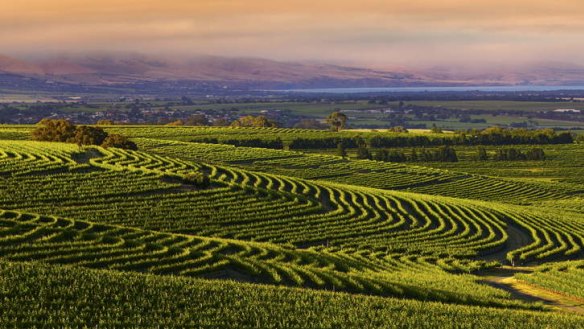Red means go in the Vale
A classic region is making a comeback by concentrating on what it does best.

McLaren Vale is alive with a new surge of vitality. It may not be the newest or sexiest wine region in the country, but it has a new lease of life and is making superb wine. Mainly red wine.
McLaren Vale's mix has changed from about 50/50 red-to-white about 15 years ago to about 80 per cent red today. And winemakers there reckon it's likely to eventually be close to 95 per cent.
What's changed is that during those 15 years a multitude of cooler-climatic regions, such as the Yarra Valley, Mornington, Tasmania, Orange, Margaret River and Adelaide Hills, have stolen the white-wine baton.
A classic example: the 80-hectare Hickinbotham vineyard at Clarendon, which was bought 18 months ago by the major American wine group Jackson Family Wines, is midway through a reorganisation in which dozens of hectares of its white grapes will be either pulled out or grafted over to reds. This vineyard had 10 hectares of chardonnay, six of sauvignon blanc, five of pinot noir and other blocks of semillon and viognier when the Jackson family moved in. This was planted in the 1970s and '80s before the advent of regions that do these varieties much better than McLaren Vale.
Now, all wine regions are becoming more focused, specialising in the varieties and styles to which they're best suited.
Jackson Family, which has owned another McLaren Vale winery, Yangarra Estate, for 12 years, is just one of the big changes in the region. Gemtree has had a multimillion-dollar injection of Chinese money that is enabling it to expand, improve and get serious about marketing - partly to China. The large, venerable family company Angove - based in the Riverland for the past 40 years - has moved in and is doing great things. It bought an established vineyard, built a stylish cellar-door outlet and restaurant on the block and is making superb wines - better than ever in its 127-year history.
McLaren Vale also has had a better run of recent vintages than anywhere, except Western Australia: 2010, '12 and '13 … even 2011 in ''the Vale'' was much better than most of south-eastern Australia. It missed some of the rainy weather and its sea breezes helped dry the vines between showers. Many excellent wines were made, and some lovely whites - just look at Battle of Bosworth's 2011 chardonnay. Those who do still grow white grapes are sensibly looking more to the Mediterranean varieties. At Oliver's Taranga and Angove, it's vermentino and fiano. At Yangarra and d'Arenberg, it's marsanne, roussanne and viognier.
The trend towards biodynamic and organic viticulture is also big in ''the Vale'', and growing. Angove bought its 10-hectare Warboys vineyard in the late '90s and went biodynamic immediately. Battle of Bosworth is a leader in organics, and recently took over a neighbouring Tyrrell's vineyard and is converting it. Other prominent practitioners are Gemtree, Yangarra and Paxton - the last a major vineyard owner with 240 hectares either owned or managed, most of it biodynamic. McLaren Vale is ahead of the game in sustainable viticulture, and it has an enterprising new project that focuses on terroir: Scarce Earth.
There are 80 wineries in the region and probably 130 producers, if you include those that have their wine made for them. As long as they're registered with the McLaren Vale Sustainable Winegrowing program, they're eligible to produce a shiraz from a specific block of vines and enter it in the Scarce Earth Project, which is in its fourth year.
McLaren Vale has a more diverse geology than most wine regions. The locals have been busy mapping and classifying their soils, and their geological map details more than 40 distinct geologies, which range in age from 15,000 years to more than 550 million years. This has been refined to 19 distinct soil and rock associations. These have been published on a separate map of soil-based subregions, such as Christie's Beach Formation, Blanche Point Formation, Pirramimma Sandstone and Maslin Sand. Winemakers entering Scarce Earth must nominate the soil type their wines come from.
The vines have to be at least 10 years old, and the wine undergoes a checking process. A tasting panel of six people, which includes me, tastes and vets the wines for faults, rejecting any that are too oaky or otherwise fail to express the region. A high level of oak can mask regional and vineyard identity, and vineyard character is what the organisers want to showcase. Vineyard and regional characters result, at least in part, from soils and the geology from which they derive.
Last year, 23 2011-vintage shirazes were approved. This year, the panel approved 37 of the 55 wine samples submitted. Last year's harvest was outstanding, which accounts for the rise in number. There's a limit of three for each winery, so some will have to make a selection: d'Arenberg, for instance, had five wines approved.
The 2011 wines went on sale from April 27, initially at cellar door only because of their small volumes - generally between 50 and 150 dozen. From August 1, they can be marketed more widely, if quantities allow. These are full-bodied, rich, concentrated wines destined to age well and exhibit true regional characteristics. My favourite 2011s are:
Shingleback Unedited, $80; d'Arenberg The Blind Tiger, $102; Kangarilla Road Scarce Earth Project, $60; Battle of Bosworth Chanticleer, $45; d'Arenberg The Vociferate Dipsomaniac, $102; d'Arenberg The Piceous Lodestar, $102; Gemtree Uncut, $30; Penny's Hill Footprint, $65; Chapel Hill The Chosen House Block and Chapel Hill The Chosen Road Block, both $75; Hugh Hamilton Black Blood Cellar Vineyard, $70. I also liked Coriole Willunga 1920 Vineyard, $50; Wistmosa, $25; Cradle of Hills Row 23, $45; Shottesbrooke Blewitt Springs Single Vineyard, $45; Halifax Per Se, $65; Battle of Bosworth Braden's, $45; and Mr Riggs Western Block, $50.
In other words, most of them!
huonhooke.com
